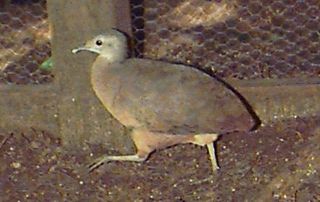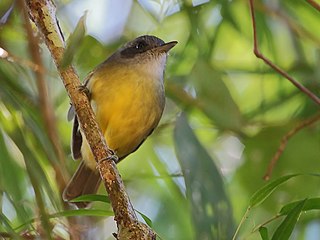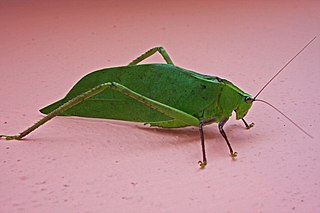
Chusquea is a genus of evergreen bamboos in the grass family. Most of them are native to mountain habitats in Latin America, from Mexico to southern Chile and Argentina.

Historically, classification of the Indigenous peoples of the Americas is based upon cultural regions, geography, and linguistics. Anthropologists have named various cultural regions, with fluid boundaries, that are generally agreed upon with some variation. These cultural regions are broadly based upon the locations of the Indigenous peoples of the Americas from early European and African contact beginning in the late 15th century. When Indigenous peoples have been forcibly removed by nation-states, they retain their original geographic classification. Some groups span multiple cultural regions. Peoples can also be classified by genetics, technology, and social structure.

The little tinamou is a species of tinamou. It is found in Central and South America, as well as on the Caribbean island of Trinidad.

The plain antvireo is a passerine bird species in subfamily Thamnophilinae of family Thamnophilidae, the "typical antbirds". It is found in Mexico, every Central American country except El Salvador, on both Trinidad and Tobago, and in every mainland South American country except Chile, French Guiana, Suriname, and Uruguay.

Pouteria is a genus of flowering trees in the gutta-percha family, Sapotaceae. The genus is widespread throughout the tropical Americas, with outlier species in Cameroon and Malesia. It includes the canistel, the mamey sapote, and the lucuma. Commonly, this genus is known as pouteria trees, or in some cases, eggfruits.

The common tapeti, also known as the Brazilian cottontail, forest cottontail, or (formerly) simply tapeti is a species of cottontail rabbit. It is small to medium-sized with a small, dark tail, short hind feet, and short ears. As traditionally defined, its range extends from southern Mexico to northern Argentina, but this includes several distinctive population that have since been split into separate species. Under this narrower definition, the true common tapeti only occurs in the Atlantic Rainforest of coastal northeastern Brazil and it is classified as "Endangered" by the IUCN. The American Society of Mammalogists concurs, but also tentatively classifies several distinct populations that have not yet received proper species names into S. brasiliensis, and thus considers it to range from Venezuela south to Argentina.

The wedge-billed woodcreeper is a sub-oscine passerine bird in subfamily Dendrocolaptinae of the ovenbird family Furnariidae. It is found in Mexico, Central America, Brazil, Bolivia, Ecuador, French Guiana, Guyana, Peru, Suriname, and Venezuela.

The white-throated round-eared bat is a bat species found from Honduras to Bolivia, Paraguay and Brazil. It creates roosts inside the nests of the termite, Nasutitermes corniger. It thrives on a mainly insect-based diet, focusing on the surfaces of foliage to hunt, and also eats fruit and pollen. It has a very wide range and is a common species over much of that range, so the International Union for Conservation of Nature has assessed its conservation status as being of "least concern".

Crypturellus is a genus of tinamous containing mostly forest species. However, there are the odd few that are grassland or steppe tinamous. The genus contains 21 species.
Daniel Otte is a South African-American ecologist, entomologist, world expert on crickets and grasshoppers and prominent scientific illustrator. He has made significant contributions to evolutionary biology. He is curator and chairman of the Department of Entomology at the Academy of Natural Sciences in Philadelphia.
Microcentrum angustatum is a katydid from South America and the Caribbean
Panoploscelis is a genus of very large insects belonging to the true katydid tribe Eucocconotini, which is a subfamily of the Tettigoniidae. Like the other members of the suborder Ensifera, Panoploscelis are part of the insect order Orthoptera, which also contains crickets, grasshoppers and locusts. Members of this genus are among the largest katydids of the Neotropics.

Microcentrum retinerve is a species in the family Tettigoniidae ("katydids"), in the order Orthoptera. A common name for Microcentrum retinerve is lesser angle-winged katydid. Microcentrum retinerve is found in North America.

Microcentrum rhombifolium is a species of insect in the family Tettigoniidae. Common names include greater angle-wing katydid, broad-winged katydid, and angular-winged katydid. They live across North America in trees and shrubs. Adults reach 50–65 millimetres (2.0–2.6 in) in length and are rhombus-shaped. Their green coloration mimics leaves. Adults are active in late summer and autumn and have a "ticking" call.

Stilpnochlora couloniana is a species of phaneropterine katydid in the family Tettigoniidae, native to southeastern United States, the Bahamas and Cuba. It is known as the giant katydid and it is the largest katydid in the United States, with an average length of 6.6 cm (2.6 in) in adult males and 7.8 cm (3.1 in) in adult females. Individuals from Cuba tend to grow 5–10% larger than those from the United States. They are sometimes kept as pets.

Pterophylla camellifolia, the common true katydid, is a common North American insect in the family Tettigoniidae (katydids). Within the Tettigoniidae, it belongs to the subfamily Pseudophyllinae. Other common names include northern true katydid and rough-winged katydid.

Capnobotes fuliginosus is a species of katydid known as the sooty longwing. It is found in the western United States and Mexico. It is omnivorous and it is the prey of the wasp Palmodes praestans.

Psinidia fenestralis, known generally as longhorn band-wing grasshopper, is a species of band-winged grasshopper in the family Acrididae. Other common names include the long-horned grasshopper, long-horned locust, and sand locust. It is found in the Caribbean and North America.

Orophus is a small genus of katydids native to Mexico, Central America, and South America.

Moncheca is a genus of relatively large, colorful conehead katydids in the tribe Copiphorini, native to the Neotropics.



















